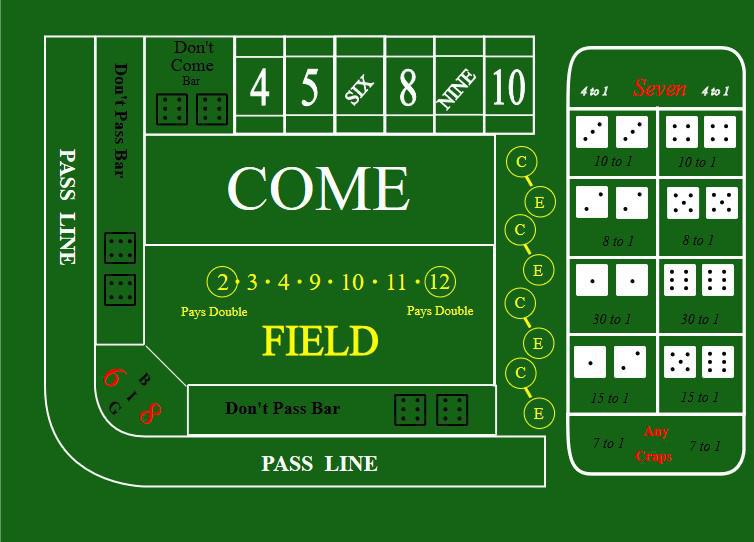Craps Betting The Field Strategy

Craps is a game with a lot of bets. There are field bets, proposition bets, hardway bets, and more to choose from. There are almost 100 different bets you could make on every roll of the dice. The casino is counting on you to make those bets because most of them are bad for the player. In this strategy wait for 2-3 non-field #'s. Then bet 1 unit on field. Every win is taken and 1 unit is played. After 2-3 NF #'s. If lost it is martingaled -as- 3, 7, 15 units only. If won we are always plus. Chances of F # coming is 46% on every roll, this chance increases after each roll, after 2-3 rolls chances are very high. Of course, craps players should always remember that the house advantage jumps to 5.55% in case that the Field paid double on both 2 and 12, so they are not recommended to use it. However, this betting pattern could turn out effective in order for the player to draw profit at a time when the table is cold. Uses Martingale System of betting progression. Max Loss – Huge The method basically entails having about $200-400 in chips on your tray, so that you can once again chase any losses up at least 6 rolls if necessary.
The Craps Mini Field-Place System Tested
by Steve “Heavy” Haltom
Regardless of the fact that no system out there will beat a negative expectation game over the long run, articles about betting systems and strategies seem to get far more positive comments from readers than any other articles we publish. For that reason, in this article we’re going to focus on none other than with the infamous Field-Place System. Sold in magazines, bookstores, and on-line under dozens of different names for sixty years or more, the Field-Place System is one of the oldest strategies around. These days a popular variant is called the Iron Cross. Barstow used to call a similar strategy the Treadmill, which in itself should tell you what he thought of it. It’s been marketed as the 87% System, the Anything but Sevens System, the Fremont Street Grind, and under at least a dozen more names – many of which I won’t mention here because they were the names the players came up with for this play after investing hundreds of dollars in it and losing thousands more.
The play itself is relatively simple. Most of you are well acquainted with it. You make Place bets on the Five, Six, and Eight plus a bet in the Field. The Field bet covers the Two, Three, Four, Nine, Ten, Eleven, and Twelve. You’ll sometimes see urban players running a similar strategy using the Big 6-8 bet instead of Place betting the Six and Eight. These guys like the “self-service” bets like the Big 6-8 and the Field and play more of an intuitive game than most of us. Irregardless, the idea is to cover every number on the dice except the Seven. It’s better to make two unit bets on the place action and one unit bets in the Field but you can play it at the one unit level, which is what we’re talking about here when we discuss the “Mini Field-Place System.” You risk four units total and you are guaranteed some sort of a win (or a push on the urban version assuming the player also places the five) on every toss – unless that Seven shows. For players who first “discover” this system it’s often some sort of a “Eureka!” moment. They believe they’ve found the Dutchman’s Lost Mine. Then they take it to the table and learn the truth about Fool’s Gold.
How do the payouts work in this play? Let’s assume a $5 game that pays double on the Two and triple on the Twelve in the Field. You’ll have to wager $6 each on the Six and Eight Place bets but can get by with $5 on the Five and in the Field, so your total wager will be $22. Now, you could take that same $22 and bet $22 inside, but you’d only get paid if an inside number rolled. Remember, the Field-Place System, which we’re playing at the table minimum, gets you paid on every decision unless the seven rolls. Here are the payouts:

Two Rolls – Pays $10 in the Field
Three Rolls – Pays $5 in the Field
Four Rolls – Pays $5 in the Field
Five Rolls – Lose the $5 Field bet – win $7 for the Place bet – Net Win $2
Six rolls – Lose the $5 Field Bet – win $7 for the Place bet – Net Win $2
Eight rolls – Lose the $5 Field Bet – win $7 for the Place bet – Net Win $2
Nine Rolls – Pays $5 in the Field
Ten Rolls – Pays $5 in the Field
Eleven Rolls – Pays $5 in the Field
Twelve Rolls – Pays $15 in the Field
So far the math looks great on this system. It’s all win win win – pay pay pay. Of course, on your two strongest numbers – the Six and the Eight – your wins are diluted by your loss in the Field. The loss on the win on the Five Place bet in the Field also dilutes the win there. Those diluted payoffs – combined with the frequency at which the Seven rolls in relation to the other numbers – turn this into a negative expectation strategy. On average, for every 36 rolls of the dice you’ll win $123, but you’ll also lose $132. That’s a $9 loss over 36 rolls, or .25 cents a roll for those of you who are struggling with Common Core math.
Of course, what the system player is looking for is enough variance in the game to put him ahead so that he can walk away with a win. He may approach the game with a number in mind – say to win $150. But to get the kind of variance he needs on a dollar per dollar basis he can’t rely on volatility alone. So he has to increase his bet size. Instead of betting $5 on the Five and $6 on the Six and Eight he tests out different amounts. Say $50 on the Five, $60 on the Six and Eight and $25 in the Field. The logic is that he’s always assured of getting green chips in his payout so he’ll reach that $150 win objective quicker. The problem is that variance is a two-edged sword. To front that sort of average bet he needs a session bankroll of $1500 instead of $150. The stack of quarters extracted from every decision adds up quickly. And don’t forget – you only WIN one bet at a time. When the Seven shows ALL of those bets lose. I recall standing next to a guy who was playing the system at this level once. He was loudly bragging to everyone at the table how great it was as he locked up a full rail of green chips. Then he started to get quiet as the chips began to migrate back to the other side of the table. In the end he gave it all back plus what he bought in for – and went back to the ATM for a bankroll infusion and re-buy. He had the volatility he needed. He just didn’t have the discipline to quit while he was ahead.
Out of curiosity, I noodled around and found an archival test of the Field-Place System against the 72 Hours at the Casino book. Admittedly, the 14,967 rolls in that book have a slight dark-side bias, so it was obvious that the system would fare worse than in the statistical example cited above. It was even worse than I expected. The total win was $50,969. The total loss was $56,628. The net loss was $5,659.
72 hours at the casino. 72 of the most miserable hours of your life. It works out to about 36 two hour sessions or 18 four hour sessions. Hell, there was a time when I played that much in a single weekend. These days it might take me a month to get in that much play. Still, do you have an extra $5,659 to lose making $5 minimum bets?

Neither do I. And now you know why I hate this play.
Do yourself a favor. Just say no to this sort of thing and learn to beat the game by influencing the dice and betting the dice right.